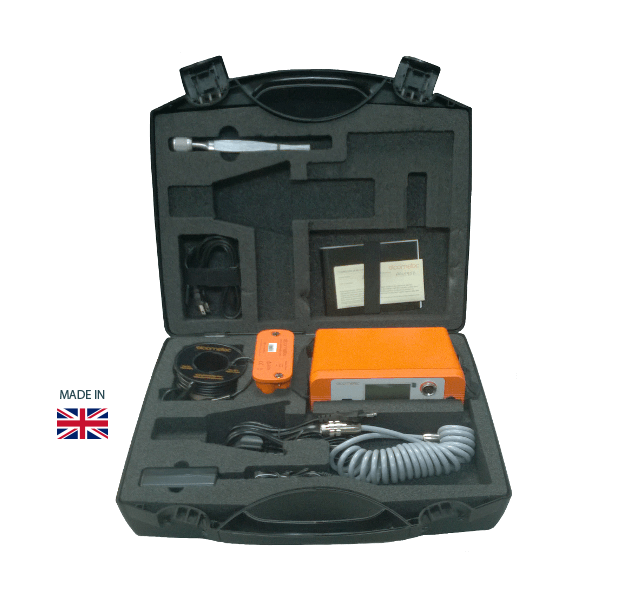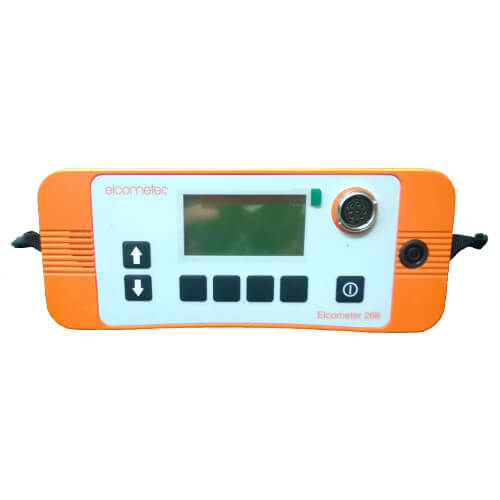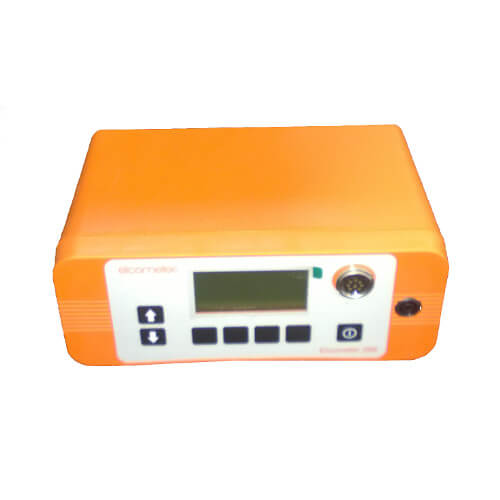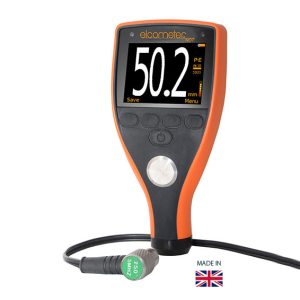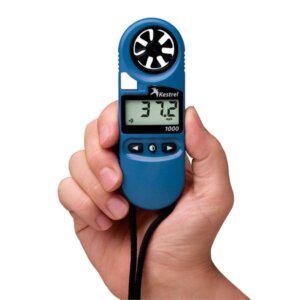Test porosity on coatings up to 7 mm (275 mils) to test coatings on pipelines and other protective coatings.
This holiday detector has a built-in voltage calculator to determine the correct test voltage based upon the test standard and the given coating thickness. It is used to test porosity on coatings up to 7 mm (275 mils) thick. The Elcometer 236 gives you complete control of voltage and sensitivity settings and is available in 2 versions, 15kV and 30kV.
Collectively referred to as porosity, the main types of flaws are:
Runs & Sags: Coatings move under gravity leaving a thin dry film.
Cissing: When a coating does not re-flow to cover the voids generated by air bubbles being released from the surface of a coating.
Cratering: If the substrate is wet or the coating has poor flow characteristics, voids are created in the coating.
Pinholes: Caused by air entrapment which is then released from the surface, or by the entrapment of particulates (dust, sand etc.) which do not stay in place.
Over Coating: If too much coating is applied, as it cures internal stresses of the coating can cause it to crack.
Under Coating: Uncoated areas, or where the coating flows away from edges or corners of a substrate or welds. Insufficient coating over a rough surface profile may also leave the peaks of the profile exposed.
There are essentially, three flaw detection methods in our range:
Wet Sponge Technique: A low voltage is applied to a moist sponge. When the sponge moves over a coating flaw, liquid
penetrates to the substrate and completes an electrical circuit, setting off the alarm. The wet sponge technique is suitable for measuring insulating coatings less than 500μm (20mils) on conductive substrates, and is ideal for powder coatings and
other coatings where the user does not wish to damage the coating.
High Voltage Technique: The high voltage, or porosity technique, can be used to test coatings up to 25mm (1”) thick and is ideal for inspecting pipelines and other protective coatings. Coatings on concrete can also be tested using this method.
A power supply generates a high voltage DC or pulsed DC to a probe. As the probe passes over a flaw, a spark at the contact point sets off the alarm. This technique is suitable for locating the types of flaws described above, although care is required on thin coatings.
UV Pinhole Detection: UV light can be used as a low cost, quick method of detecting pinholes in coatings. A base coat containing a UV fluorescing additive is applied. When the UV flashlight shines on the coating, areas where the base coat is not covered fluoresce, identifying the location of the pinhole.
How to set up an Elcometer 266 holiday detector
The Elcometer 266 revolutionises High Voltage DC testing of coatings porosity detection making it safer, easier and more reliable than ever before.
Tough
Rugged, shockproof and water resistant, each unit is designed for use even in the harshest of environments. Ideal for testing clean, damp,
dirty or slightly conductive coatings.
Versatile
Using the wide range of probe accessories, users can detect porosity/holidays in coatings up to 25mm (1”) thick.
User Friendly
Balanced, ergonomic design, complete with shoulder strap allows long periods of continuous use. Flashing display, bright LED and a user adjustable volume alarm indicates detection of a holiday.
Safe
Featuring a two stage safety switch, bright LED’s and screen icons which signify when the high voltage is on. It is designed with extended ribbing to protect the user from spark creep. Safety trigger integrated inside the handle cuts power if released. Voltage calculator automatically sets the correct voltage from your coating thickness value.
Powerful
The high voltage pulsed DC technique is used to detect holidays in coatings – even if the coating is damp, dirty or slightly conductive.
Due to its unique design, the probe handle can be replaced with a telescopic probe handle – extending the measurement reach up to almost 4m (13’), ideal for testing on large/high structures.
COMES WITH PROBES SOLD SEPARATELY
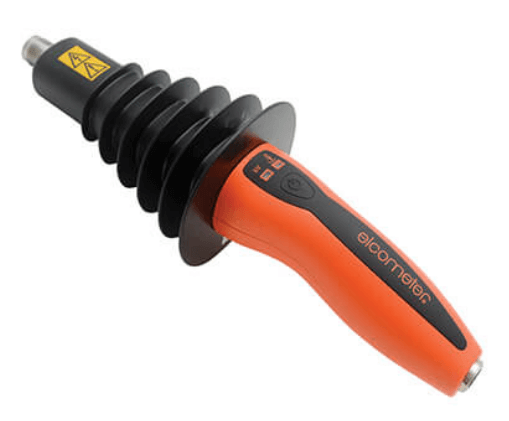
For 266 DC Holiday DETECTOR PROBE HANDLES, pls click here
Elcometer 266 DC Holiday Detector available at a great price
| Part Number | Description | ||
| D266—-4 | Elcometer 266* | ||
| High Voltage Output Accuracy | ±5% or ±50V below 1000 Volts | ||
| Operating Temperature | 0°C to 50°C (32°F to 120°F) | ||
| Power Supply | Rechargeable lithium-ion battery, fully charged within 4 hours | ||
| Measured Current Flow Accuracy | ±5% of full-scale Output Current:0 – 100µA maximum | ||
| Typical Battery Life – Backlight Off (On) | DC5: 40 (20) hours | DC15: 20 (15) hours | DC30: 10 (8) hours |
| Instrument Case Dimensions | Waterproof, ABS case; 520 x 370 x 125mm (20.5 x 14.5 x 5”) | ||
| Weight | Base unit (including battery pack): 1.2kg (2.7lb) Handle: 0.6kg (1.3lb) | ||
| Certificate available | Certificate of Calibration: issued for Fixed Calibration equipment and shows readings and traceability | ||
| Packing List | Elcometer 266 DC Holiday Detector, lithium battery, curly connection cable for high voltage handle, 10m (32’) signal return lead, battery charger with 3 mains cables (UK, EUR and US), band brush, shoulder strap, tough plastic carry case and operating instructions | ||
*The Elcometer 266 does not include the probe handle; please select the required handle the accessories
Indications
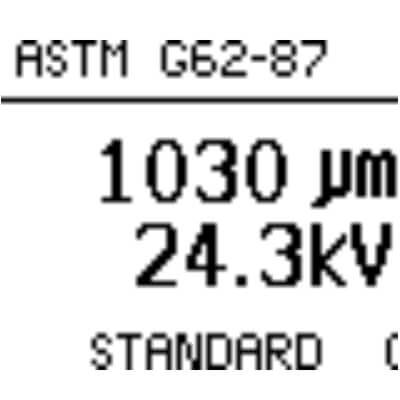 |
|
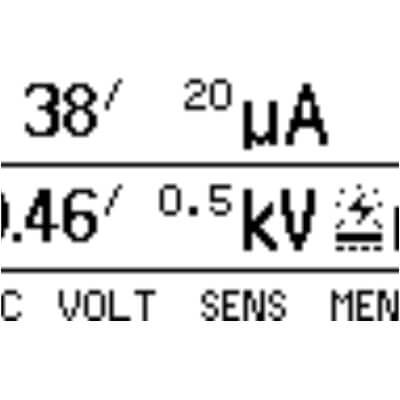 |
|
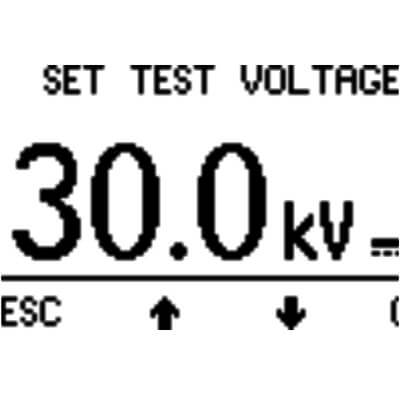 |
|
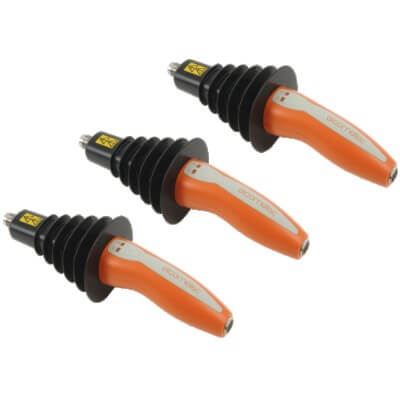 |
|
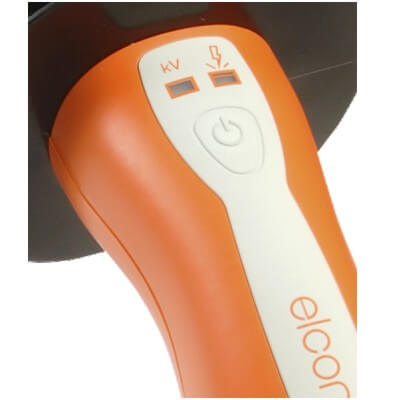 |
|
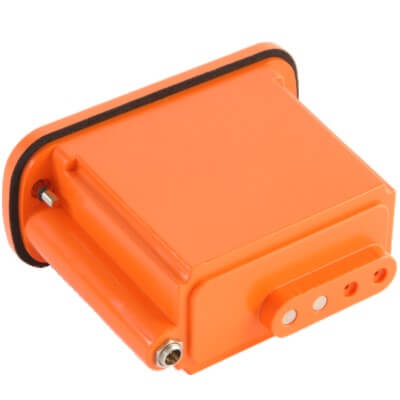 |
|
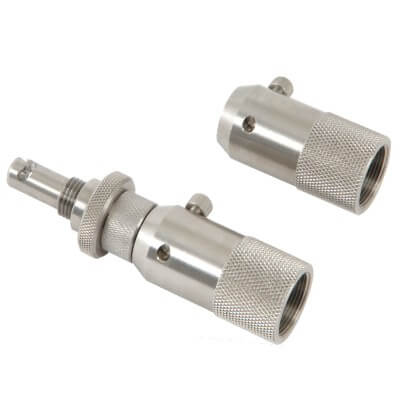 |
|
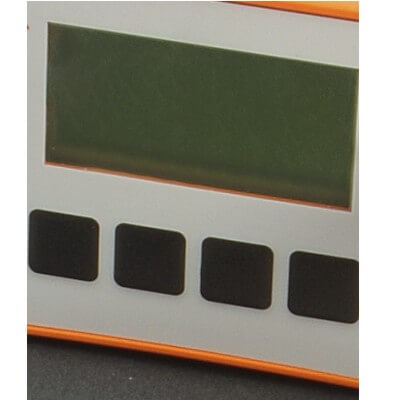 |
|
 |
The optional second-hand grip is designed for two-handed use without compromising its safety. Ideal for testing pipes and tank floors. |
 |
|
Safety Features
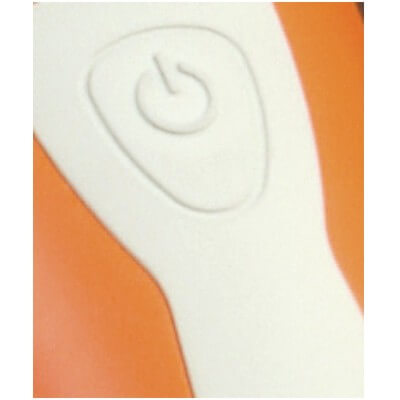 |
|
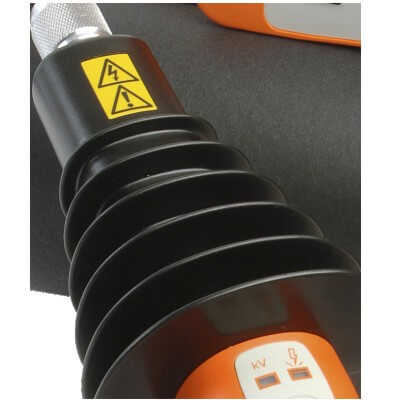 |
|
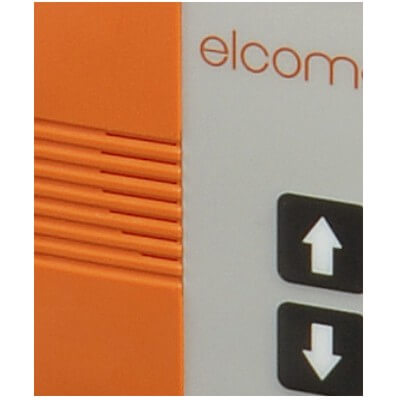 |
|
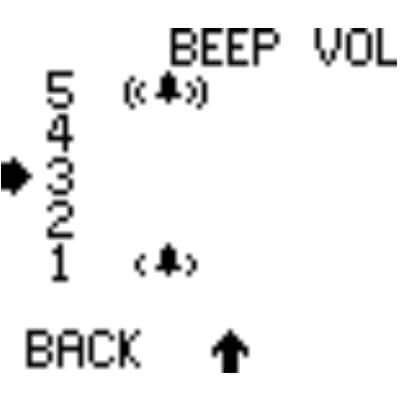 |
|
Standards
Can be used in accordance with:
ANSI/AWWA C213, AS 3894.1, ASTM C 536, ASTM C 537, ASTM D 4787, ASTM G 6, ASTM D 5162-B, ASTM G 62-B, BS1344-11, DIN 55670, EN 14430, ISO 2746, JIS K 6766, NACE RP0274, NACE RP0188, NACE RP0190, NACE RP0490, NACE SP0188, NACE SP0490
Standards in grey have been superseded but are still recognized in some industries.
QUICK TIP – HOLIDAY TESTS EXPLAINED:
High voltage holiday detection
A high voltage holiday test is normally used to determine the existence of discontinuities in coating films. The high voltage, or porosity technique, can be used to test coatings up to 25mm (1″) thick and is ideal for inspecting pipelines and other protective coatings. Coatings on concrete can also be tested using this method. There are two types of high voltage holiday detectors – Continuous DC and Pulsed DC.
Continuous DC Holiday Detection
Continuous DC holiday detectors, such as the Elcometer 236 Holiday Detector, require direct connection to the conductive substrate. The Elcometer 236 holiday tester provides the user with complete control of voltage and sensitivity settings and is available in 2 versions- 15kV and 30kV.
Pulsed DC Holiday Detection
Using Pulsed DC holiday detection technology, the Elcometer 280 Pulsed DC Holiday Detector is designed to ensure that the energy is contained within very short pulses, each pulse having more energy than an equivalent continuous DC system. This means that the Elcometer 280 holiday detector can be used to test for holidays over slightly conductive coatings, or dirty or damp surfaces. Using state-of-the-art electronics, the Elcometer 280 holiday detector allows users to inspect coatings – without connecting the earth return lead to the component substrate – ideal for inspecting large surfaces and pipelines. From the two-stage safety switch, bright LED’s, and screen icons signifying when the high voltage is on, to the extended ribbing to protect the user from spark creep, the Elcometer 280 Pulsed DC Holiday Detector sets the standard for high voltage measurement safety.
With a wide range of probes and accessories available, a high voltage holiday test can be carried out on a variety of substrates with a different coating thickness and is suitable for all applications.
Test porosity on coatings up to 7 mm (275 mils) to test coatings on pipelines and other protective coatings.
This holiday detector has a built-in voltage calculator to determine the correct test voltage based upon the test standard and the given coating thickness. It is used to test porosity on coatings up to 7 mm (275 mils) thick. The Elcometer 236 gives you complete control of voltage and sensitivity settings and is available in 2 versions, 15kV and 30kV.
Collectively referred to as porosity, the main types of flaws are:
Runs & Sags: Coatings move under gravity leaving a thin dry film.
Cissing: When a coating does not re-flow to cover the voids generated by air bubbles being released from the surface of a coating.
Cratering: If the substrate is wet or the coating has poor flow characteristics, voids are created in the coating.
Pinholes: Caused by air entrapment which is then released from the surface, or by the entrapment of particulates (dust, sand etc.) which do not stay in place.
Over Coating: If too much coating is applied, as it cures internal stresses of the coating can cause it to crack.
Under Coating: Uncoated areas, or where the coating flows away from edges or corners of a substrate or welds. Insufficient coating over a rough surface profile may also leave the peaks of the profile exposed.
There are essentially, three flaw detection methods in our range:
Wet Sponge Technique: A low voltage is applied to a moist sponge. When the sponge moves over a coating flaw, liquid
penetrates to the substrate and completes an electrical circuit, setting off the alarm. The wet sponge technique is suitable for measuring insulating coatings less than 500μm (20mils) on conductive substrates, and is ideal for powder coatings and
other coatings where the user does not wish to damage the coating.
High Voltage Technique: The high voltage, or porosity technique, can be used to test coatings up to 25mm (1”) thick and is ideal for inspecting pipelines and other protective coatings. Coatings on concrete can also be tested using this method.
A power supply generates a high voltage DC or pulsed DC to a probe. As the probe passes over a flaw, a spark at the contact point sets off the alarm. This technique is suitable for locating the types of flaws described above, although care is required on thin coatings.
UV Pinhole Detection: UV light can be used as a low cost, quick method of detecting pinholes in coatings. A base coat containing a UV fluorescing additive is applied. When the UV flashlight shines on the coating, areas where the base coat is not covered fluoresce, identifying the location of the pinhole.
How to set up an Elcometer 266 holiday detector
The Elcometer 266 revolutionises High Voltage DC testing of coatings porosity detection making it safer, easier and more reliable than ever before.
Tough
Rugged, shockproof and water resistant, each unit is designed for use even in the harshest of environments. Ideal for testing clean, damp,
dirty or slightly conductive coatings.
Versatile
Using the wide range of probe accessories, users can detect porosity/holidays in coatings up to 25mm (1”) thick.
User Friendly
Balanced, ergonomic design, complete with shoulder strap allows long periods of continuous use. Flashing display, bright LED and a user adjustable volume alarm indicates detection of a holiday.
Safe
Featuring a two stage safety switch, bright LED’s and screen icons which signify when the high voltage is on. It is designed with extended ribbing to protect the user from spark creep. Safety trigger integrated inside the handle cuts power if released. Voltage calculator automatically sets the correct voltage from your coating thickness value.
Powerful
The high voltage pulsed DC technique is used to detect holidays in coatings – even if the coating is damp, dirty or slightly conductive.
Due to its unique design, the probe handle can be replaced with a telescopic probe handle – extending the measurement reach up to almost 4m (13’), ideal for testing on large/high structures.
COMES WITH PROBES SOLD SEPARATELY

For 266 DC Holiday DETECTOR PROBE HANDLES, pls click here
Elcometer 266 DC Holiday Detector available at a great price
| Part Number | Description | ||
| D266—-4 | Elcometer 266* | ||
| High Voltage Output Accuracy | ±5% or ±50V below 1000 Volts | ||
| Operating Temperature | 0°C to 50°C (32°F to 120°F) | ||
| Power Supply | Rechargeable lithium-ion battery, fully charged within 4 hours | ||
| Measured Current Flow Accuracy | ±5% of full-scale Output Current:0 – 100µA maximum | ||
| Typical Battery Life – Backlight Off (On) | DC5: 40 (20) hours | DC15: 20 (15) hours | DC30: 10 (8) hours |
| Instrument Case Dimensions | Waterproof, ABS case; 520 x 370 x 125mm (20.5 x 14.5 x 5”) | ||
| Weight | Base unit (including battery pack): 1.2kg (2.7lb) Handle: 0.6kg (1.3lb) | ||
| Certificate available | Certificate of Calibration: issued for Fixed Calibration equipment and shows readings and traceability | ||
| Packing List | Elcometer 266 DC Holiday Detector, lithium battery, curly connection cable for high voltage handle, 10m (32’) signal return lead, battery charger with 3 mains cables (UK, EUR and US), band brush, shoulder strap, tough plastic carry case and operating instructions | ||
*The Elcometer 266 does not include the probe handle; please select the required handle the accessories
Indications
 |
|
 |
|
 |
|
 |
|
 |
|
 |
|
 |
|
 |
|
 |
The optional second-hand grip is designed for two-handed use without compromising its safety. Ideal for testing pipes and tank floors. |
 |
|
Safety Features
 |
|
 |
|
 |
|
 |
|
Standards
Can be used in accordance with:
ANSI/AWWA C213, AS 3894.1, ASTM C 536, ASTM C 537, ASTM D 4787, ASTM G 6, ASTM D 5162-B, ASTM G 62-B, BS1344-11, DIN 55670, EN 14430, ISO 2746, JIS K 6766, NACE RP0274, NACE RP0188, NACE RP0190, NACE RP0490, NACE SP0188, NACE SP0490
Standards in grey have been superseded but are still recognized in some industries.
QUICK TIP – HOLIDAY TESTS EXPLAINED:
High voltage holiday detection
A high voltage holiday test is normally used to determine the existence of discontinuities in coating films. The high voltage, or porosity technique, can be used to test coatings up to 25mm (1″) thick and is ideal for inspecting pipelines and other protective coatings. Coatings on concrete can also be tested using this method. There are two types of high voltage holiday detectors – Continuous DC and Pulsed DC.
Continuous DC Holiday Detection
Continuous DC holiday detectors, such as the Elcometer 236 Holiday Detector, require direct connection to the conductive substrate. The Elcometer 236 holiday tester provides the user with complete control of voltage and sensitivity settings and is available in 2 versions- 15kV and 30kV.
Pulsed DC Holiday Detection
Using Pulsed DC holiday detection technology, the Elcometer 280 Pulsed DC Holiday Detector is designed to ensure that the energy is contained within very short pulses, each pulse having more energy than an equivalent continuous DC system. This means that the Elcometer 280 holiday detector can be used to test for holidays over slightly conductive coatings, or dirty or damp surfaces. Using state-of-the-art electronics, the Elcometer 280 holiday detector allows users to inspect coatings – without connecting the earth return lead to the component substrate – ideal for inspecting large surfaces and pipelines. From the two-stage safety switch, bright LED’s, and screen icons signifying when the high voltage is on, to the extended ribbing to protect the user from spark creep, the Elcometer 280 Pulsed DC Holiday Detector sets the standard for high voltage measurement safety.
With a wide range of probes and accessories available, a high voltage holiday test can be carried out on a variety of substrates with a different coating thickness and is suitable for all applications.

 1 item
1 item
